WASHINGTON, D.C. – U.S. Senators Catherine Cortez Masto (D-Nev.) and Jacky Rosen (D-Nev.), along with Representatives Steven Horsford (D-Nev.-04), Dina Titus (D-Nev.-01), Mark Amodei (R-Nev.-02) and Susie Lee (D-Nev.-03), today announced compromise legislation, the Desert National Wildlife Refuge and Nevada Test and Training Range Withdrawal and Management Act, that preserves the jurisdiction of the Refuge and boundaries of the Nevada Test and Training Range (NTTR) while also providing Nevada’s service members at Nellis Air Force Base and the NTTR the resources they need by supporting modernization requirements and accounting for increased public safety needs. If enacted, this legislation would create 1,310,806 acres of wilderness, the largest wilderness designation in Nevada history.
“It is critical that we find balance between conserving our public lands and ensuring we maintain the strategic importance of the Silver State to our national security. Our proposal continues to support the Air Force’s combat training mission while designating new wilderness for our state’s wildlife to protect the pristine lands we in Nevada call home,” dijo el Senador Rosen. “I’m hopeful this bipartisan compromise legislation will help resolve land management conflicts and preserve public access to the Desert National Wildlife Refuge. I have met with environmental advocates, tribal leaders, and Air Force senior leadership on this issue. I’ll continue working with our local stakeholders – including military leaders, environmental and wildlife advocates, and members of Nevada’s tribal communities – to make sure all voices are heard.”
“Nevadans have made clear that they do not support the expansion proposal offered by the United States Air Force. And I stand with them,” said Senator Cortez Masto. “Our legislation addresses the concerns of our community while also ensuring the Air Force has the resources and support it needs to keep our country safe. In my extensive engagement with Nevadans, it was clear that our local communities needed more of a say in the process so that local economies are protected, religious and cultural sites of importance to our Native communities are respected and all those who frequent these beautiful natural spaces can enjoy them. This comprehensive bill gives all stakeholders a forum to express their land management concerns through designated agency points-of-contact. This bill also marks a clear boundary between Refuge lands perpetually open to the public, and those Refuge lands where military training activities will continue under Air Force co-management with the Fish and Wildlife Service. Tribes and the general public will be allowed limited, timely access to these co-managed lands. I look forward to working with stakeholders in Nevada to advance this legislation through the Senate.”
“As a Nevadan, I know how important the Desert National Wildlife Refuge is to my state. The Wildlife Refuge is one of the most pristine and unaltered landscapes in the U.S. It has been protected as a vital sanctuary for Nevada’s natural environment and wildlife for more than 80 years,” said Congressman Horsford. “I am proud to support this legislation, which will be the largest conservation bill in the history of the state of Nevada. I am honored that our state is so crucial to our country’s national defense; however, the Department of Defense already has nearly 3 million acres in southern Nevada for testing and training — with a portion of more than 800,000 acres of the Refuge already closed to public access. Despite overwhelming public opposition, the Department of Defense has not reconsidered any portion of its proposal, which would close most of the refuge to public access and threaten Nevada’s state animal—the bighorn sheep. Nevadans deserve continued access to this treasured desert habitat.”
“I am proud to stand with the Nevada Delegation in support of this historic proposal which protects the largest wildlife refuge in the Lower 48 and ensures that the Air Force has the training tools it needs to keep us safe,” said Congresswoman Titus. “The Desert National Wildlife Refuge has preserved iconic flora and fauna for nearly a century, and we must protect this critical habitat for future generations to enjoy and explore. Importantly, this legislation elevates the voices of native tribes and local communities in managing this jewel of the southwest.”
“I was pleased to see the concepts unveiled in the meeting and look forward to refining and finalizing Nevada’s concerns as a delegation while continuing to work alongside the USAF and other relevant stakeholders so this can be a win-win for everyone involved, and serve as a springboard for the Clark County lands bill update,” said Congressman Amodei.
“The Desert National Wildlife Refuge and the Nevada Test and Training Range have had a defining presence in our state for roughly eight decades, but now it’s time to bring these federal lands into the 21st century,” said Congresswoman Lee. “I, along with my Nevada colleagues in Congress, stand united in our commitment to finding a compromise that conserves our pristine desert habitats, strengthens our national security, and respects the heritage of Nevada’s Native American communities. I will continue to work with the Nevada congressional delegation and all stakeholders to ensure that the DNWR and NTTR serve the best interests of Nevadans. ”
BACKGROUND:
This bill was developed after extensive discussions and engagement with Nevada stakeholders including tribal communities, conservationists, sportsmen and hunters, private landowners, the U.S. Fish and Wildlife Service (USFWS) and the United States Air Force (USAF).
The Nevada State Legislature enacted a resolution opposing the expansion of the NTTR. The Moapa Band of Paiutes also passed a tribal resolution against any further military expansion into the Refuge.
The Desert National Wildlife Refuge and Nevada Test and Training Range Withdrawal and Management Act:
• Maintains USFWS primary jurisdiction of the Refuge and allows access to the co-managed lands, at least on a monthly basis for the agency to manage wildlife maintenance activities and water development projects, while also preserving access for tribal, recreational, hunter/sportsman, education and research interests.
o Requires a Memorandum of Understanding be created by USAF and USFWS for the management of the co-managed lands.
o Establishes authority for USAF to provide mitigation payments for fish and wildlife habitat support consistent with their impacts and use of the land.
• Preserves public access and USFWS jurisdiction east of the historic Alamo/Old Corn Creek Road, including the dry lake bed.
• Creates four wilderness areas within the lands co-managed by USAF and USFWS, comprising a total of 645,998 acres.
• Creates four wilderness areas within the lands solely managed by USFWS, comprising a total of 664,808 acres.
• Extends the withdrawal for the Nevada Test and Training Range for an additional 20 years until November 6, 2041.
• Creates a permanent Tribal Resource Officer, to be recommended by local tribes, to work with USAF and USFWS on mitigating impacts in the co-managed lands and to be involved in required cultural resources investigations.
• Establishes an “Interagency Committee” for the purpose of resolving management conflicts between USAF and USFWS.
• Establishes an “Intergovernmental Executive Committee” for Nevadans and other interested stakeholders to exchange views, information, and advice relating to the management of the natural and cultural resources of the lands withdrawn under this Act.
o USAF and USFWS will also be required to appoint agency liaisons to interface with the public and members of the “Executive Committee.”
• Provides for a buffer area around the southeast boundary of the co-managed lands to prevent unintended trespass and support public safety.
• Allows for the Air Force, in consultation with the Department of Interior to place up to 15 threat emitters to maximize and enhance realistic pilot training.
• Provides for a buffer area around the southeast boundary of the co-managed lands to prevent unintended trespass and support public safety.
The bill text can be found aquí.
###

